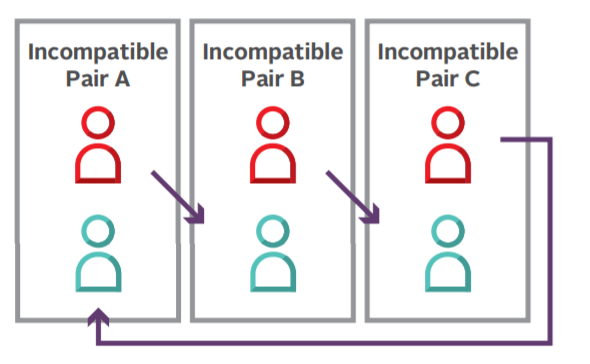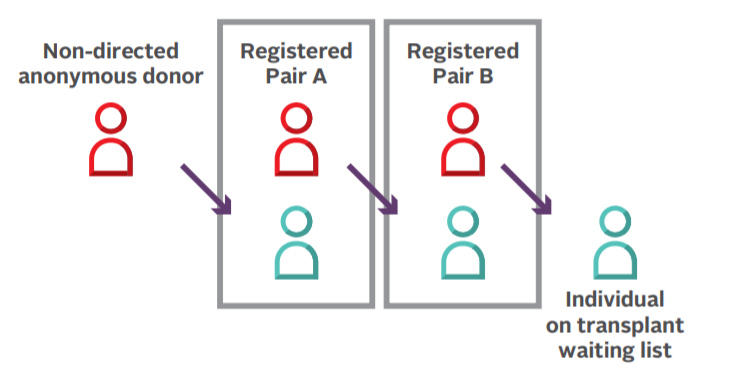Kidney Paired Donation (KPD) Program
The national Kidney Paired Donation (KPD) program is an interprovincial organ sharing program operated by Canadian Blood Services in collaboration with Canada’s living kidney donation and kidney transplant programs. The KPD program gives individuals an opportunity to become a living donor and donate a kidney to someone in need, and in doing so, provide transplant candidates an increased opportunity to receive a transplant.
Any adult who is in general good health can be assessed to become a living kidney donor. If you are interested in learning more about participating in this program, please visit blood.ca/en/organs-tissues
KPD program data dashboard
This interactive dashboard reports on the Kidney Paired Donation (KPD) program. The data presented here is updated monthly. This dashboard provides information on the number of registered participants in the KPD program, matches created each match cycle, and kidney transplants facilitated by the program. Data is also provided on kidneys that are shipped between centres for transplant.
About the KPD program
Living donation programs and kidney transplant programs across Canada register the potential living donors and transplant candidates into the Canadian Transplant Registry (CTR). The CTR is a secure computer database managed by Canadian Blood Services through which sophisticated matching algorithms identify potentially medically suitable matches of transplant candidates with potential donors and non-directed anonymous donors (NDADs). The matching algorithm compares the medical information of all the pairs and NDADs and identifies chains of potential kidney transplant opportunities. Once potential exchanges/chains are identified, medical teams must determine if it is possible to complete all the matches in the chain before the transplants and donations can proceed.
The Kidney Paired Donation program is completely voluntary. All potential donors, NDADs and transplant candidates have the choice to proceed or withdraw from the process at any time.
There are three types of KPD chain exchanges:
1) Paired Exchange
In a paired exchange, Donor A wishes to donate a kidney to transplant Candidate A, but they are not a match. Donor B would like to donate a kidney to transplant Candidate B, but they are not a match. However, Donor A is a match with transplant Candidate B and Donor B is a match with transplant Candidate A. A paired exchange is then completed.
2) N-Way Exchange or Closed Chain
An n-way exchange, or closed chain, is similar to a paired exchange, except there are more pairs included and the donor of the last pair donates to the transplant candidate of the first pair.

The information and images in these materials may be used with inclusion of a source credit to Canadian Blood Services. For more information, consult creative commons © 2018 Canadian Blood Services.
3) Domino Exchange or Domino Chain
Domino exchanges begin with a non-directed anonymous donor (NDAD) who donates to the transplant candidate of a registered pair. There can be multiple registered pairs in a domino exchange as you can see below with pairs A and B.
The exchange is complete when the donor of the last registered pair donates to a transplant candidate on a transplant waitlist.

The information and images in these materials may be used with inclusion of a source credit to Canadian Blood Services. For more information, consult creative commons © 2018 Canadian Blood Services.
Paired Exchange, Closed Chain, Domino Exchange - A Short Presentation
The information and images in these materials may be used with inclusion of a source credit to Canadian Blood Services.
Power of one—the non-directed anonymous donor (NDAD)
NDADs are very important to the success of the KPD Program. When a non-directed anonymous donor — a person who is not paired with a transplant candidate, yet wishes to donate a kidney to someone in need — enrolls in the KPD program, their kidney donation is not conditional on a friend or family member receiving a transplant in return. This allows the KPD program to identify chains of exchanges that create significant numbers of transplant possibilities that otherwise would not be possible.
Non-directed donors greatly increase the number of matches that can be made among the registered pairs in the CTR.
Since they enter as a single rather than a pair, it also means that at the end of the domino exchange, one patient on the deceased donor waiting list also receives a kidney transplant.
More information
Quick links to public information site
- About the Living Donation Storytelling Project
- Kidney paired donation (public information site)
- My Transplant Coach Canada (patient education modules)
- My Paired Donation Coach Canada (patient education modules)
- Living kidney donation programs
For a list of all Canadian living kidney donation programs and to access/download brochures in multiple languages, visit this URL https://www.blood.ca/en/livingdonation
Programs can request KPD and Living Donation information brochures in English and French by emailing otdt@blood.ca. Brochures in 10 other languages can be downloaded from https://www.blood.ca/en/organs-tissues/living-organ-donation/kidney-paired-donation
Shipping of Living Donor Kidneys - In response to questions received about shipping and receiving living donor kidney processes and logistics, Canadian Blood Services invited a panel of experts to respond. A Shipping Kidney’s Q&A panel session was held Sept. 1, 2020. The meeting video recording and materials can be found here.
Terminology:
Match Cycle (MC): A Match Cycle begins with identification of matches between a specified group of potential donors and transplant candidates. It ends when all the identified matches are transplanted or can no longer proceed.
Pair: A transplant candidate and a potential donor who register in the KPD Program together.
Transplant Candidate: Someone who needs a kidney transplant and has been registered in the KPD Program, as a Pair, with a potential donor.
Directed Donor: A potential donor can be assessed to donate to someone they know such as a family member or friend. If tests determine they are a medically compatible match, the donation and transplant can proceed.
Non-Directed Anonymous Donor (NDAD): Someone who wishes to donate a kidney to anyone in need. NDADs start off domino chains.
Active Transplant Candidate: Someone who needs a kidney transplant, is registered in the KPD Program as a Pair with a potential donor, and is ready and able to be matched to another potential donor in the next match run.
Domino Chain: a series of potential candidate/donor matches that begins with a non-directed anonymous donor (NDAD). The donor of the last pair of the chain donates to a patient on a provincial waitlist.
Paired (2 Way) Exchange: Donor A wishes to donate a kidney to Recipient A, but they are not a match. Donor B would like to donate a kidney to Recipient B, but they are not a match. However, Donor A is a match with Recipient B and Donor B is a match with Recipient A. A paired exchange can then be completed.
Closed Chain: A closed chain (also called an n-way exchange) is similar to a paired exchange, except there are more pairs included and the donor of the last pair donates to the recipient of the first pair.